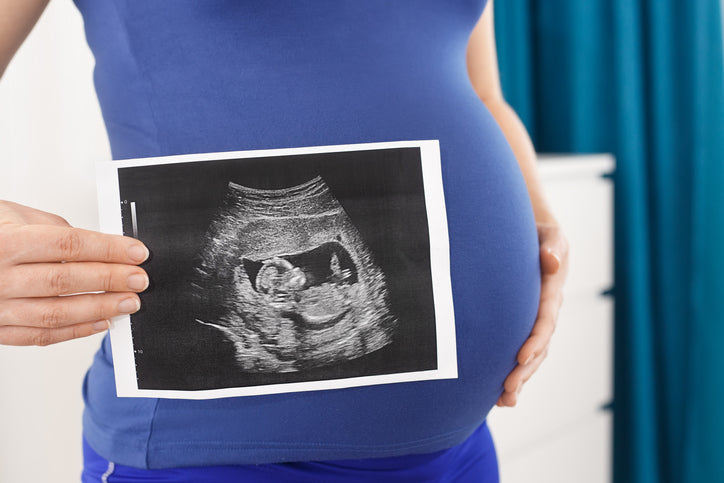Extra Pregnancy Ultrasounds: What To Know

Your doctor or midwife may recommend one or more of the following sonograms throughout your pregnancy, for various reasons. There may be genetic reasons for extra scans, or a low lying placenta that could threaten a vaginal delivery. You may have suffered previous miscarriages, or you are simply over the age of 35 and your doctor requires extra screening.
There are numerous reasons to receive sonograms other than the 20 week anatomy scan or an early dating ultrasound.
1st Trimester Scan (NT Scan)
Having a trans-abdominal sonogram between 12-13 weeks is performed to confirm your baby’s heartbeat and conclude first trimester screening for chromosomal abnormalities.
The screening can identify Down's Syndrome (Trisomy 21 or T21), Edwards' Syndrome (Trisomy 18 or T18), and Patau's Syndrome (Trisomy 13 or T13).
The screening test offered at 11-14 weeks is called the 'Combined Test.' It involves a blood test and an ultrasound scan. If a screening test shows that you have a higher risk of having a baby with Down's, Edwards' or Patau's syndromes, you will be offered diagnostic tests to confirm.
In addition to screening for these abnormalities, a portion of the test (known as the nuchal translucency - NT) can assist in identifying other significant fetal abnormalities, such as cardiac disorders.
The combined accuracy rate for the scan to detect the chromosomal abnormalities mentioned above is approximately 85% (with a false positive rate of 5%). A positive test means you have a 1/100 to 1/300 chance of experiencing one of the abnormalities.
Level II Scan
While technically the anatomy scan is a Level II Scan, there are other reasons to come in for a Level II sonogram. During your anatomy sonogram, you will learn if another Level II scan is needed. Level II scans are reserved for higher-risk mothers, but may be used to rule you out of the high-risk category.
Common reasdons for a Level 2 ultrasound include family history of birth defects, maternal medical problems associated with birth defects, exposure to medications associated with birth defects, a maternal age of 35 or older, abnormal serum screening results, and birth defects suspected on a Level 1 ultrasound.
While there is no ultrasound that can detect 100% of birth defects, most birth defects that are undetected with a Level 2 ultrasound are typically less significant.
A survey of your baby’s internal organs will be conducted, as well as:
- The umbilical cord
- Amniotic fluid
- Location of the placenta
- Fetal heart rate
This ultrasound helps determine if your baby should be delivered earlier than originally planned.
Bpp Scan (Biophsyical Profile)
This sonogram combines an ultrasound evaluation with a non-stress test (NST) and is intended to determine fetal health during the third trimester.
It is performed if there is a question about a baby's health, maternal/baby symptoms, or if the pregnancy is considered high risk.
There are two parts to the BPP:
- A Non-Stress Test (NST): The NST involves attaching one belt to the mother’s abdomen to measure fetal heart rate, and another belt to measure contractions. Movement, heart rate, and “reactivity” of heart rate to movement are measured for 20-30 minutes.
- An Ultrasound Evaluation: The ultrasound portion may take up to an hour, and the technician will watch for a variety of signs that are important in measuring the health of your baby.
Fetal Non-Stress Test Scan (NST)
The Fetal Non-Stress Test is a simple, non-invasive test performed in pregnancies over 28 weeks gestation. As mentioned above, The NST involves attaching a belt to the mother’s abdomen to measure fetal heart rate, and another belt to measure contractions. Movement, heart rate, and “reactivity” of heart rate to movement are measured for 20-30 minutes. A NST may be performed if:
- You sense the baby is not moving as frequently as usual
- You are overdue
- There is any reason to suspect the placenta is not functioning adequately
- You are high risk for any other reason
The test can indicate if the baby is not receiving enough oxygen because of placental or umbilical cord problems; it can also indicate other types of fetal distress. The primary goal of the test is to measure the heart rate of the fetus in response to its own movements.
Healthy babies will respond with an increased heart rate during times of movement, and the heart rate will decrease at rest. The concept behind a non-stress test is that adequate oxygen is required for fetal activity and heart rate to be within normal ranges. When oxygen levels are low, the fetus may not respond normally. Low oxygen levels can often be caused by problems with the placenta or umbilical cord.







